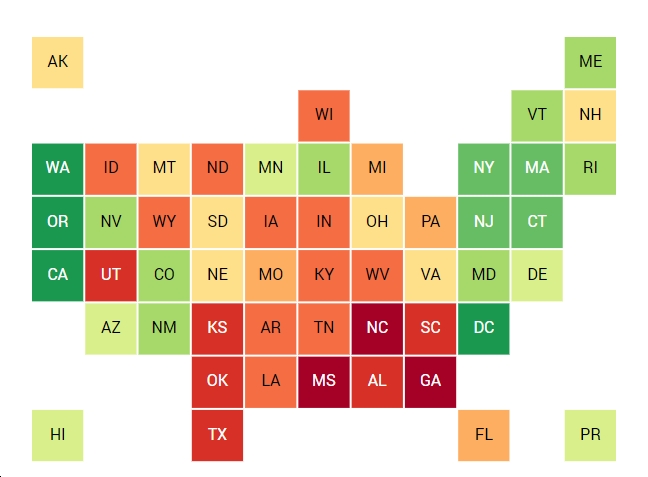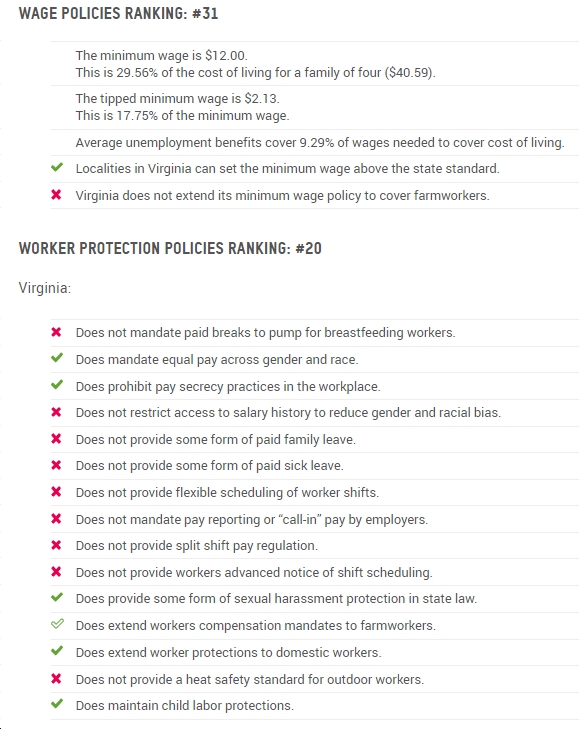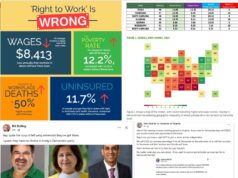Check out the following press release from Oxfam America, regarding its annual “Best States to Work Index.” For some context, keep in mind that under Republican mis-governance, Virginia ranked an utterly abysmal #52 back in 2019. Then, after just a year of a Democratic “trifecta,” Virginia rocketed up to #23 in 2021 – a direct result of communities and workers organizing for policy change, spurring and enabling important actions taken by the Virginia legislature (under Democratic control) and then-Gov. Ralph Northam.
And now, according to this brand-new report, Virginia’s pretty much leveled off under divided government (Republicans controlling the governorship and House of Delegates, Democrats with a narrow State Senate majority), clocking in this year at #28, down from #22 in 2022. In short, if Virginians want to keep moving up the rankings, we’re going to need to elect another Democratic “trifecta” in 2025, and of course do whatever we can so that Republicans don’t get full control this November. There’s a great deal at stake in these elections – whether on working people, voting rights, abortion rights, environmental proection, LGBTQ protections, stopping Youngkin’s assault on public education, you name it – so let’s get to work!
******************************************
Best and worst states to work 2023: California, Oregon top the list, while North Carolina, Mississippi lag far behind
Now in its fifth anniversary, Oxfam’s annual index highlights rapidly growing inequality among states
Ahead of Labor Day, Oxfam America released its annual Best States to Work Index, a robust database and interactive map that measures policies supporting working families in all 50 states, plus Washington, DC and Puerto Rico. The Index tracks 26 policies in three areas—wages, worker protections, and rights to organize—that seek to capture which have stepped in to fill the gaps left by federal inaction to support workers and their families.
“Millions of working families across the U.S. are stuck in cyclical patterns of poverty because of the federal government’s failure to provide essential policies like access to paid leave and livable wages,” said Dr. Kaitlyn Henderson, senior research adviser with Oxfam America’s US Domestic Policy Program and lead author of the Index. “But the impacts of this inaction are not affecting all communities equally. At the end of the day, it comes down to where these workers live and what jobs they have, and it’s clear that these realities are exacerbating inequality in the U.S., especially on lines of gender, race, and class.”
This year, California earns the top spot in the Index as the “best” state for workers, followed closely by Oregon (#2), the District of Columbia (#3), New York (#4), and Washington (#5). On the other hand, North Carolina lands at the very bottom of the Index as the “worst” state, followed by Mississippi (#51), Georgia (#50), South Carolina (#49), and Alabama (#48).
The top five states in the Index feature some of the strongest minimum wages in the country, provide paid leave, and ensure child labor protections. Three of the five—California, Oregon, and Washington—have heat standards for outdoor workers. In contrast, all five lowest-ranking states have a minimum wage stuck at the federal level of $7.25, none mandate paid leave, and all have so-called “right-to-work” laws on the books.
The 2023 Index also comes on the heels of what has come to be known as “hot labor summer,” due to both the record-breaking temperatures and a real explosion of labor organizing and workers striking for their rights. Four states tie for first place in the rights to organize dimension with a perfect score of 100: California, the District of Columbia, New York, and Oregon. At the bottom, with scores of zero, Georgia, North Carolina, South Carolina, and Texas have no support for worker organizing, whether by public or private employees.
“Too many crucial federal labor standards have not changed in well over a decade, so the best states for workers have consistently passed new legislation that fills those gaps,” continued Henderson. “Our research shows a strong correlation between robust labor policies and better measures of household income, food security, and even lower rates of infant mortality. It’s critical that both federal and state governments invest in workers’ pay, protections, and collective action, because these policies can have a substantial impact on improving wellbeing for workers and their families. The benefits of supporting workers are undeniable.”
Oxfam’s Index reveals how political choices at the state level can result in meaningful progress in the face of federal inaction. The last twelve months have brought about some exciting developments in new worker protections, particularly in a number of states across the Midwest. That includes Michigan, which overturned its “right-to-work” law (the first state to overturn such a law in decades), as well as Illinois and Minnesota, both of which passed paid leave policies covering both family leave and sick leave. In Minnesota’s case, workers can receive up to 20 weeks of paid family leave.
Together with the Index, Oxfam also released the third edition of the Best States for Working Women, which ranks states based on policies that either directly or disproportionately support women workers, such as equal pay, flexible scheduling, and paid leave. In this Index, Oregon is the “best” state for working women, followed by California, New York, Illinois, and Washington. On the other end of the spectrum, many of the same “worst” states can also be seen at the bottom of the women’s index: North Carolina is the “worst” state for working women, followed by Alabama, Mississippi, and Georgia.
“Unfortunately, where a woman lives and works defines whether she will be treated with dignity and respect in the workplace and whether or not she can provide for a family. Stagnating wages and occupational segregation in the U.S. disproportionately harm women, specifically women of color, who are often caught in low-wage positions lacking paid family or paid sick leave and are overwhelmingly breadwinners for their families,” said Henderson. “This year’s federal passage of the Pregnant Worker Fairness Act and the PUMP Act are important steps in the right direction, and these policies are only the beginning. We need coordinated, deliberate political action at the federal and state levels to ensure working women across the country are protected and supported.”
The Best States to Work Index offers opportunities at both the federal and the state levels for policymakers to proactively improve the lives and realities of workers and working families. Oxfam recommends the following urgent policies:
Raise Wages: The federal minimum wage has not been raised from $7.25 an hour since 2009. Both at the state and the federal levels, Oxfam calls on policymakers to raise the wage. At both levels, subminimum tipped wages should be abolished, minimum wage exclusions of certain workers must end, and the minimum wage needs to be lifted.
Strengthen Worker Protections: There is a great need for stronger worker protections at the state and federal levels, including paid family and medical leave, stronger equal pay laws, a heat standard for workers, and protections for domestic workers. There are already bills available for the federal government to adopt and improve the worker protection landscape for all workers in the U.S. And some states are moving to strengthen worker protections on their own.
Protect Rights to Organize: The federal government must enshrine and expand the rights of workers to bargain and build power collectively. States, meanwhile, can support rights to organize, including by repealing “right-to-work” laws and protecting the rights of state and local employees, including public school teachers, to collectively bargain.
















